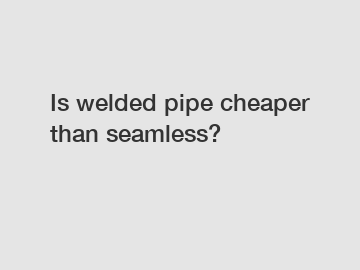Is welded pipe cheaper than seamless?
When it comes to the construction industry, choosing the right type of pipe is crucial. Two popular options are welded pipe and seamless pipe. Welded pipes are created by welding a flat plate of steel into a cylindrical shape, while seamless pipes are produced by piercing a solid billet of steel and then rolling it into a cylindrical shape. One common question that arises when deciding between the two is, "Is welded pipe cheaper than seamless?" In this article, we will delve into the factors that determine the cost of each type of pipe and help you make an informed decision for your next project.
Cost Factors for Welded Pipe.
Welded pipes are typically less expensive than seamless pipes due to the manufacturing process involved. Welded pipes are made by joining together two ends of a steel plate using welding techniques, which are less expensive and time-consuming than the processes used to create seamless pipes. Additionally, the availability of raw materials for welded pipes is higher, leading to lower production costs. This makes welded pipes a cost-effective option for projects with budget constraints.

Another factor that influences the cost of welded pipes is the size and complexity of the pipe. Larger diameter pipes and pipes with intricate designs or specific requirements may require more welding and finishing processes, adding to the overall cost. However, even with these additional costs, welded pipes are still generally more affordable than seamless pipes.
Cost Factors for Seamless Pipe.
Seamless pipes are known for their superior strength and reliability, making them a popular choice for high-pressure applications and critical infrastructure projects. However, this quality comes at a price. The manufacturing process for seamless pipes is more complex and time-consuming than that of welded pipes, involving multiple steps such as piercing, rolling, and heat treatment. This results in higher production costs, making seamless pipes more expensive than welded pipes.
Additionally, the availability of raw materials for seamless pipes may impact the cost. Seamless pipes require solid billets of steel, which can be more costly and harder to source compared to flat plates used for welded pipes. These factors contribute to the higher price of seamless pipes, making them a premium option for projects where strength and durability are paramount.
Choosing Between Welded and Seamless Pipes.
When deciding between welded and seamless pipes, it is essential to consider the specific requirements of your project and weigh them against cost considerations. If budget is a primary concern and the application does not require the extreme strength and reliability of seamless pipes, welded pipes may be the more economical choice. On the other hand, if your project demands the highest quality and performance, seamless pipes may be worth the investment despite their higher cost.
Ultimately, the decision between welded and seamless pipes depends on a variety of factors, including project specifications, budget constraints, and performance requirements. By evaluating these factors and understanding the cost differences between the two options, you can make an informed choice that meets your needs while staying within your budget.
Contact Us.
If you have any further questions or need assistance in selecting the right type of pipe for your project, feel free to contact us. Our team of experts is here to help you make the best choice based on your specific requirements and budget constraints.
For more HDPE Double Wall Corrugated Pipe for Rainwater system, PVC Irrigation Pipe for Rainwater system, Pressure-resistant HDPE Steel Bellowsinformation, please contact us. We will provide professional answers.

Comments